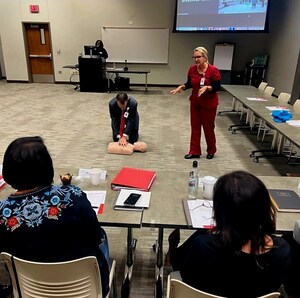American Heart Association Meeting Report: Patients in Stroke Belt Satisfied With Care, But Many Doctors Lack Cultural Awareness
-- Most patients in the southeastern United States are satisfied with their care and trust their doctors -- though many physicians don't ask questions that would indicate multicultural awareness, according to a survey.
-- Physicians view themselves as moderately prepared for cross-cultural patient care, although 18 percent of them consider multicultural training to be of low importance, according to another survey.
-- Researchers say physician awareness and skill in dealing with cultural differences should be targeted to address disparities in cardiovascular health and healthcare.
WASHINGTON, May 20 /PRNewswire-USNewswire/ -- Most patients in the southeastern United States are satisfied with the care they get from their primary care doctor — though many doctors lack training for dealing with patients of different ethnic backgrounds and often fail to ask important questions that indicate multicultural awareness, according to results of two surveys presented at the American Heart Association's 11th Scientific Forum on Quality of Care and Outcomes Research in Cardiovascular Disease and Stroke.
(Logo: http://www.newscom.com/cgi-bin/prnh/20100222/AHSALOGO )
"Effective communication between patients and their doctors is critical to ensure proper care and treatment is prescribed, and it's especially important in addressing disparities in the care of high risk patients," said Jill A. Foster, M.D., M.P.H., co-author of the study and medical director at CE Outcomes, LLC, in Birmingham, Ala. "Findings from these surveys suggest that neither patients nor doctors may realize they're missing key cultural differences, an oversight that can impede health outcomes."
Foster and colleagues conducted two separate surveys of patients and healthcare providers from the nation's Stroke Belt region (Alabama, Arkansas, Florida, Georgia, Louisiana, Mississippi, North Carolina, South Carolina, Tennessee and Virginia), an area of the country where strokes are more common.
The patient survey included 1,189 people (55 percent white, 43 percent black, ages 40-75 years). The respondents' primary care physician (PCP) (70 percent white, 18 percent black) was most often a family physician (69 percent).
In the patient survey:
- Ninety percent said they were satisfied with their care and have trust in their doctors.
- Sixty-one percent reported that their doctors never asked them if they sought advice from family members when making healthcare decisions.
- Fifty-one percent said their PCPs never asked if they wanted to invite family members to participate in such decision-making.
"I think it's remarkable that these patients feel that level of trust and satisfaction in their doctors because that strong patient-physician bond represents an incredible opportunity to do good," said Clyde Yancy, M.D., lead author of the two studies and president of the American Heart Association.
The provider survey queried 697 doctors (70 percent Caucasian/white; 13 percent Asian; 7 percent African American/black; 5 percent Latino/Hispanic, 4 percent multiple/other; and 1 percent Hawaiian/other Pacific islanders).
While 76 percent of the doctors reported some prior multicultural training, 18 percent — nearly one in five — said they consider such training to be of low importance. Although the doctors' average levels of perceived cross-cultural knowledge and skills were moderate, significant deficits were noted in some areas — more than 75 percent of them said they had limited knowledge of the National Standards on Culturally and Linguistically Appropriate Services (CLAS). The standards, published in 2001, were developed after the 2000 census reflected increased diversity in the U.S. population.
The goal of the CLAS standards is to help ensure that culturally diverse patients receive effective healthcare. Healthcare institutions that receive federal funds are required to follow four of the 14 standards, those covering language assistance services. Individual medical practices are encouraged but not required to follow the standards.
"Doctors involved in primary prevention must motivate patients and make sure they understand the importance of changing unhealthy lifestyle habits, such as smoking, or taking daily medication for conditions like high blood pressure or diabetes long before those things make the patients feel ill," said Yancy, medical director of the Baylor Heart and Vascular Institute and chief of Cardiothoracic Transplantation at Baylor University Medical Center in Dallas, Texas.
Results from both the patient and physician studies found significant differences associated with physicians' ethnic background. In the physician survey, black doctors, on average, were more likely to see themselves as most culturally attuned and prepared for multicultural healthcare delivery, followed by Asian physicians and white physicians in terms of attitudes, and cross-cultural knowledge and skills, Foster said.
The patient survey additionally revealed statistically significant differences between races:
- White patients were more likely than blacks to recall being asked if they used any traditional folk remedies.
- Patients with black physicians were more likely than those with white physicians to report being asked about their family's role in making health decisions and whether family members should be invited to participate in making decisions.
- Similarly, patients with black physicians reported more frequent use of various explanatory behaviors such as: encouraging patients to stop him/her when the patient becomes confused; asking if the patient understands the instructions and repeating them if necessary; and asking if the patient has any other questions before leaving the office.
"But even with the overwhelming satisfaction reported by all racial/ethnic groups in the survey, culturally competent behaviors are only some of the many things that determine a patient's level of satisfaction and trust in their doctors," Foster said.
One possible limitation of the patient survey is that respondents had to have seen their PCPs within the last year. Thus, the survey may not reflect the experiences of patients who have difficulty establishing a primary care relationship or avoid getting healthcare.
Foster characterized the survey findings as first steps to future research, but noted the findings add further support for interventions that make healthcare more culturally appropriate and patient-centered.
Other co-authors of both studies include Gregory D. Salinas, Ph.D.; Andrew R. Sanchez, M.S.; and Linda L. Casebeer, Ph.D. Author disclosures are on the abstracts.
This research was supported through an educational grant from Pfizer, Inc., to the American Heart Association Professional Education Department.
Statements and conclusions of study authors that are presented at American Heart Association scientific meetings are solely those of the study authors and do not necessarily reflect association policy or position. The association makes no representation or warranty as to their accuracy or reliability. The association receives funding primarily from individuals; foundations and corporations (including pharmaceutical, device manufacturers and other companies) also make donations and fund specific association programs and events. The association has strict policies to prevent these relationships from influencing the science content. Revenues from pharmaceutical and device corporations are available at http://www.americanheart.org/corporatefunding.
Additional Resources:
- For more information on stroke, visit the American Stroke Association Web site: strokeassociation.org.
- Downloadable stock footage and animation are available at www.americanheart.mediaroom.com, click on "Multimedia Resources."
- For video clips on stroke awareness, warning signs, cultural differences in risk, calling 9-1-1, etc.: http://americanheart.mediaroom.com/index.php?s=98&cat=108&mode=gallery and http://americanheart.mediaroom.com/index.php?s=98&cat=107&mode=gallery
SOURCE American Heart Association
WANT YOUR COMPANY'S NEWS FEATURED ON PRNEWSWIRE.COM?
Newsrooms &
Influencers
Digital Media
Outlets
Journalists
Opted In






Share this article